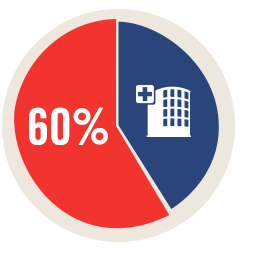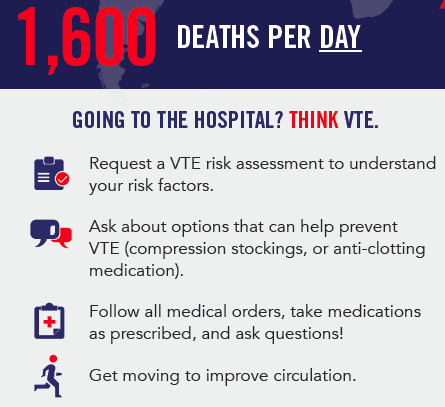Know Hospital-Associated VTE
Being in the hospital is a major risk factor for the development of venous thromboembolism (VTE). Patients with decreased mobility - due to bedrest or recovery - or who experience blood vessel trauma - due to surgery or other serious injury - are more likely to develop blood clots.

In fact, up to 60 percent of all VTE cases occur during or within 90 days of hospitalization, making it a leading preventable cause of hospital death.
To prevent VTE, hospital staff should evaluate patients for their risk of developing blood clots and use proper prevention and treatment procedures. Read more about VTE risk assessments and prevention.
 Facts and Figures
Facts and Figures
- Up to 60 percent of VTE cases occur during or after hospitalization, making it a leading preventable cause of hospital death.8
- In the U.K, upwards of 32,000 cases of hospital-associated VTE occur every year.9
- In the U.S., more than 540,000 hospitalized patients develop VTE.10
- In Australia, 30,000 cases of hospital-associated VTE occur every year.11
Procedures with Increased VTE Risk
Certain surgeries and medical procedures are considered to higher the risk for VTE, including:
- Orthopedic surgery (e.g., total hip or knee surgery)
- Major general surgery (especially involving the abdomen, pelvis, hip or legs)
- Major gynecological surgery
- Urological surgery
- Neurosurgery
- Cardiothoracic surgery
- Major peripheral vascular surgery
- Chemotherapy for cancer treatment
If you or a loved one will be undergoing any of these procedures, be sure to ask for a VTE risk assessment and talk about blood clot prevention.
Hospital VTE Protocol
To prevent hospital-associated VTE and related morbidity, every hospital worldwide should establish and enforce a VTE protocol. Protocols may vary by institution and country, but should include a VTE risk assessment that is tied to proper prevention and treatment guidelines.
While some countries have established mandated protocols, the majority have not. That’s why the WTD campaign urges hospitals, healthcare systems, policymakers and hospital quality review organizations around the world to make VTE protocol and prevention a priority patient safety issue.
8 Jha AK, Larizgoitia I, Audera-Lopez C, Prasopa-Plaisier N, Waters H, Bates DW. The global burden of unsafe medical care: analytic modeling of observational studies. BMJ Qual Saf 2013; 22;809-15. Retrieved from: http://qualitysafety.bmj.com/content/22/10/809.full.pdf+html
9 House of Commons Health Committee Report on the Prevention of Venous Thromboembolism in Hospitalised Patients. www.publications.parliament.uk/pa/cm200405/cmselect/cmhealth/99/9902.html.
10 Yusuf H, Tsai J, Atrash H, Boulet S, Grosse S. Venous thromboembolism in adult hospitalizations–United States – 2007-2009. MMWR 2012;61:no. 22:401-404
11 National Policy Framework: VTE Prevention in Adult Hospitalised Patients in NZ. New Zealand VTE Prevntion. June 2012. http://www.hqsc.govt.nz/assets/Other-Topics/QS-challenge-reports/VTE-Prevention-programme-National-Policy-Framework.pdf
